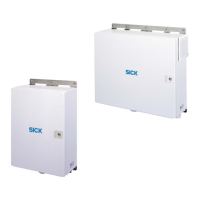Chapter 3
MSC800
8011540/14B8/2019-06-06 Operating instructions | SICK 27
Subject to change without notice
3.3 Product features and functions (overview)
Safety and ease of use
•
Control cabinet variant: reliable, compact metal cabinet, enclosure rating IP 65/IP 54, CE marking
• Automatic self-test at system start
• Diagnostic tools for system setup and (remote) system monitoring
• Configurable output of reading diagnostic data in two reading results formats
• Operating data polling, in case of error, issue of error code if required
• Test string function (heartbeat) can be activated to signal that the device is ready for
operation
• Password-protected configuration mode
• Saving of the configured parameter values (cloning) in addition to on the SD memory card
of the logic unit (can be removed when replacing the logic unit)
• Future-proof through firmware update (FLASH PROM) via data interface
• Future-oriented SOPAS-ET configuration software
• Additional supply voltage range (mains voltage IN)
• Cooling of the cabinet by fans (not MSC800-1100)
• Option to signal excess temperature in the cabinet (MSC800-1100/-2100/-2300)
• Components of the MSC800 (logic unit, power supply unit module) can each be replaced
Convenient
operation/configuration
Configuration (online/offline) and display of the image memory content via SOPAS-ET configuration
software (incl. help system)
•
Status displays of the connections on the logic unit via LEDs
Read operation modes
Start/stop operation
•
Read cycle
• External read cycle via switching input(s) or data interface
1D / 2D code
assessment
Data matrix ECC200 (PDF417 being prepared)/all common bar codes
• Separation of identical codes of the same code type by position in the image memory/read
angle along the scan line
Data processing
Influencing the reading data by event-dependent assessment conditions
•
Influencing the output string by filters and output sorting options
Data communication
•
HOST main data interface: two output formats can be configured for the reading result,
communication can be switched to various physical interfaces, parallel operation possible
• AUX auxiliary data interface: fixed output format with special diagnostic functions,
communication can be switched to various physical interfaces, parallel operation possible
Electrical
Interfaces
•
HOST data interface: serial RS-232, RS-422/485, Ethernet or PROFIBUS-DP (various configurations of
transmission rate and protocol possible)
• AUX data interface: serial RS-232, RS-422/485, Ethernet (transmission rate, data format,
and protocol fixed), USB
• CAN interface for integration of the ID sensors and of the VMS4xx/5xx into the SICK CAN
SENSOR network or into a CANopen® network
• Ethernet interface (10/100 MBit/s), TCP/IP and FTP
• Four digital switching inputs for external read cycle sensor, via optocoupler
• Four digital switching inputs for incremental encoder, via optocoupler
• Six digital switching inputs for assignable special functions
• Four digital switching outputs and two relay outputs for signaling definable events in the
read events or in system statuses
Connectivity
(design)
•
Data and function interfaces: spring-loaded terminals, D-Sub, RJ45, USB type B
• Supply voltage: spring-loaded terminals
Tab. 7 Product features and functions (overview)

